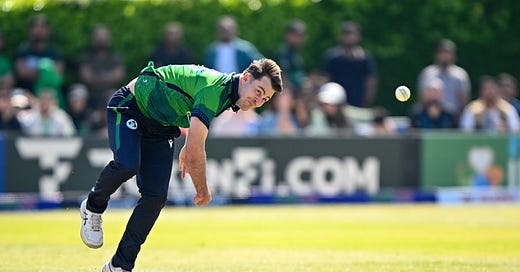Curtis Campher and the shot that echoed around Clontarf
With the game on the line, Campher played a reverse ramp to find the boundary on his first ball. To everyone else, it was a staggering piece of bravery. For Campher, it made perfect sense
Curtis Campher has never been a man of many words when speaking to the press. While always happy to talk, such is his focused personality that thoughts are often compressed into small, easy to digest soundbites.
Yet even for him, to have only 27 words to say about what was arguably the shot of the match is remarkably succinct.
With eight deliveries remaining during Ireland’s victory over Pakistan in Clontarf on Friday, Campher walked out to bat with 16 runs required. Andrew Balbirnie, who had just reached 77, was dismissed by Shaheen Afridi. Pakistan’s trump card left-arm quick wasn’t at his searing best, but he was still sharp.
Given Ireland’s recent history of succumbing to defeat from favourable positions at home - India and New Zealand most famously in recent times - a dreaded sense of deja vu would have been understandable. As Campher walked to the middle, facing up to the 14th-ranked T20I bowler in the world, he saw third man inside the ring. His eyes may well have lit up.
Shot selection made, facing his first delivery, Campher jumped into position at the last possible moment. Shaheen had no time to adjust. With pace on the ball, the Ireland all-rounder shifted to his left, flipped his gloves into a left-handed position and guided it over short third with a perfectly-executed reverse ramp, a shot similar to the one immortalised by Joe Root during last year’s Ashes.
“It was just being very clear on our positive options,” said Campher. “If you need 12 runs an over, it was a good option to go with early doors.”
27 words.
For everyone else, the shot was a combination of skill and risk that rendered it scarcely believable. Scratch that. It was batshit crazy.
For Campher, it was a simple mental calculation. Third inside the ring? Check. Strong shot option developed over years of practice? Check. Boundary required? Check.
Play the shot. Reap the rewards if it comes off. Be confident that the thought process was correct if it doesn’t. All that calculus in the seconds it took to walk from the changing room to the wicket.
Like Campher, Heinrich Malan is a very clear, process-driven individual. Outcomes are secondary to planning. Take emotion out of the situation. Does the moment call for this particular shot? Has Malan, now into his third year as head coach, simply created an environment where players like Campher can use the ice in their veins to make seemingly incalculable decisions no matter what the emotion of the game? Here lies the the dominant trend of high-level sport.
Perhaps not. Here’s Andrew Balbirnie, the man Campher replaced at the crease ahead of his stroke of genius and/or madness. “I didn't watch the last over, [I] went to the tent and put a towel over my head. I felt it was my job to get the team over the line. I believe Curtis played a ramp shot. To do that in a pressure situation was great.”
Balbirnie was an emotional wreck surrounded by incredulity. He didn’t even see Campher’s shot. At least some of these Irish players remain mere mortals, gripped by the sheer calamity of elite sport.
After that first ball audacity, Campher repeated the trick on his third delivery faced. As Abbas Afridi dropped the ball short, he looked to play an upper cut. The connection wasn’t pretty but it was effective, the ball guided past third once again and away to the fence.
In three deliveries, Campher had scored eight runs behind square. If so minded, one might question if Pakistan had done their homework. Anyone who has watched a handful of Campher innings knows he loves these shots behind square. Pakistan did not set their fields accordingly.
That Campher was even walking out to bat at the stage he did was somewhat of a surprise. Mark Adair and his superior career strike-rate was the anticipated replacement for Balbirnie given the need for boundaries.
Campher had already been demoted down the order when George Dockrell went in at number five upon Harry Tector’s dismissal. In one sense, that move too was a curious one. Dockrell is seen as a power hitter who likes pace on the ball. Memories of teams attacking him with spin and getting him out early at the last T20 World Cup ring true. Pakistan had Shadab and Imad spinning the ball away from right-handers. Was the decision-making with the line-up equally surprising to Campher?
“No, not at all,” he explains. “There’s clear communication and we all have our roles. I got the nod from Stirlo and that’s how it went.
“With match-ups and spin being on in the middle and the way George bats, it just comes so naturally to him the way he hits the ball straight, that’s the way we’ve been pretty much from the last World Cup.”
The prevailing wisdom - from this writer at least - was that, if facing trial by spin, as Ireland were with Shadab and Imad bowling, Campher is your man. He loves to sweep and paddle, shots that favour slower bowling. Dockrell, on the other hand, thrives on fast bowlers missing their yorkers, punishing them with an array of shots into the sightscreen. Hands up, Ireland’s analyst says I’m wrong.
“The way the match-ups work, if you look at the data it shows it’s the other way around,” says Campher. He loves pace, while Dockrell loves going downtown off the spinners. “That’s just the way it’s been, that’s what we’ve been doing from two years ago, that’s been the theme. Gone are the days where you slide people up and down because of negative connotations, it’s about the positive connotations in the game.
“Normally my role is, if there’s a few quick wickets, just to prolong the game until the 12th over and bat the way I bat, I naturally score quite quickly anyway. With spin in the middle and the way George hits the ball straight and the spin match-ups, it was a no-brainer.”
Was playing a reverse ramp on your first ball, facing up to Shaheen Afridi also a no-brainer?
Perhaps we shouldn’t be surprised. This is, after all, a job for these players. Leave the emotionless calculation to them. Mortals like you and I can admire bravery when it comes off and lament when it doesn’t.
On Friday, it worked. There will be further days when it does not. For now, Campher and Ireland’s cold, process-driven identity brought a level of joy which the sport on this island badly needed.







